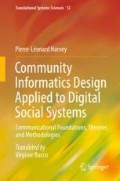Abstract
As we have previously seen, the field of science models (FOSM) provides the theoretical and practical foundations of a collective operational imagination process called community informatics design. It is nothing less than an exploratory voyage through several thinking and action modes relying on transdisciplinarity. We will now see that these thinking modes are a very concrete way of operationalizing the community informatics design thinking by seven thinking modes (Burnette 2009; Ranjan 2007) likely to help the uninitiated or social and communication science students start a design process. These seven thinking modes constitute an operational model that can intervene at different stages of the FOSM, a life cycle or a design project. Each thinking mode is articulated in several natural or specialized languages and takes into account a different aspect of the FOSM (foundations, theories, methodology or the several applications). Each contains characteristics that allow to provide specific information and knowledge appropriate to each of the instances, procedures or actions related to the FOSM. Concretely, it means that each thinking mode allows to operationalize the different users’/designers’ intentions, their behaviours, the norms, the architectures, the role distribution, the resources, the management modes, etc. These thinking modes conciliate material thinking modes (hard) and software (soft). Let us examine how these thinking modes allow to explore “imaginary territories” of an innovation culture suggested by the FOSM.
References
Barker, R. G. (1968). Ecological psychology. Stanford: Stanford University Press.
Bateson, G. (1972). Steps to an ecology of mind. New York: Random House.
Engenstrom, Y. (1999). Perspectives on activity theory, in the series: Learning in doing: Social, cognitive and computational perspectives. Cambridge University Press.
Habermas, J. (1973). Theory and Practice (trans: Viertel, J.). Boston: Beacon.
Habermas, J. (1984). The theory of Communicative Action. (trans: McCarthy, T.). Boston: Beacon.
Kling, R. (1973). Toward a person-centered computing technology, in the Proceedings of the1973 Fall Joint Computer Conference. Atlanta, August.
Kling, R. (1996). Synergies and competition between life in cyberspace and face-to-face communities. Social Science Computer Review, 14(1), 50–54.
Kling, R. (1999). Can the “next generation internet” effectively support “ordinary citizens”? The Information Society, 15(1).
Kling, R. (2000). Social informatics: A new perspective on social research about information and communication technologies. Prometheus, 18(3), 245–264.
Kling, R. (2007). What is social informatics and why does it matter? Published by the Information Society: An International Journal, 23(4), 205–220.
Kling, R., Kraemer, K. L., Allen, J. P., Bakos, Y., Gurbaxani, V., & Elliott, M. (2001). Transforming coordination: The promise and problems of information technology in coordination. In T. Malone, G. Olson, & J. Smith (Eds.), Coordination theory and collaboration technology. Mahwah: Lawrence Erlbaum.
Moles, A. A. (1981). Pensée rigoureuse et sciences du vague: du bon usage des mathématiques dans les sciences sociales. In Cahiers Internationaux de Sociologie (pp. 269–287). (incomplete).
Moles, A. A., & Jacobus, D. W. (1988). Design and immateriality: What of it in a post industrial society? Design Issues, 4, 25–32. (incomplete).
Moles, A. A., & Rohmer, E. (1998). Psychosociologie de l’espace. Paris: Éditions L’Harmattan.
Mucchielli, A. (2005). Étude des communications: approche par la contextualisation. Paris: A. Colin.
Mucchielli, A. (2006). Étude des communications: Nouvelles approches. Paris: A. Colin.
Schön, D. A. (1983). The reflective practitioner: How professionals think in action. New York: Basic Books.
Webography
Burnette, C. H. (2009). A theory of design thinking. <http://www.independent.academia.edu/charlesburnette> , consulté le 1er novembre 2011.
Heylighen, F. (2007). Why is open access development so successful? Stigmergic organization and the economics of information. http://pespmc1.vub.ac.be/papers/OpenSourceStigmergy.pdf , consulté le 19 février 2008.
Author information
Authors and Affiliations
Rights and permissions
Copyright information
© 2017 Springer International Publishing AG
About this chapter
Cite this chapter
Harvey, PL. (2017). Community Informatics Design in Action: Towards Operational Ways of Thinking in Order to Start a Design Process (Block 3). In: Community Informatics Design Applied to Digital Social Systems. Translational Systems Sciences, vol 12. Springer, Cham. https://doi.org/10.1007/978-3-319-65373-0_4
Download citation
DOI: https://doi.org/10.1007/978-3-319-65373-0_4
Published:
Publisher Name: Springer, Cham
Print ISBN: 978-3-319-65372-3
Online ISBN: 978-3-319-65373-0
eBook Packages: Computer ScienceComputer Science (R0)

